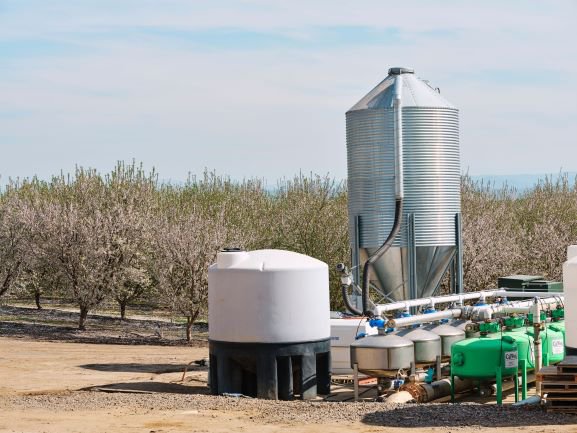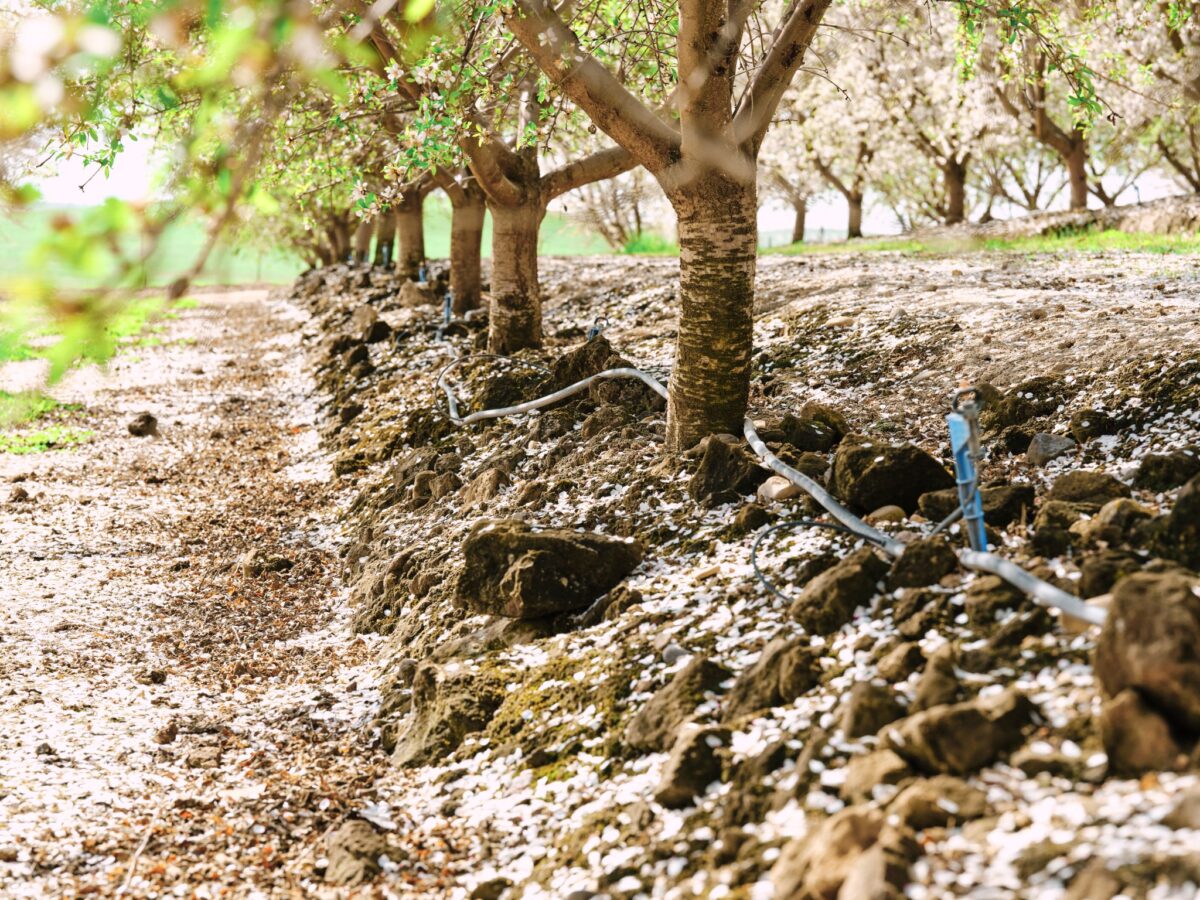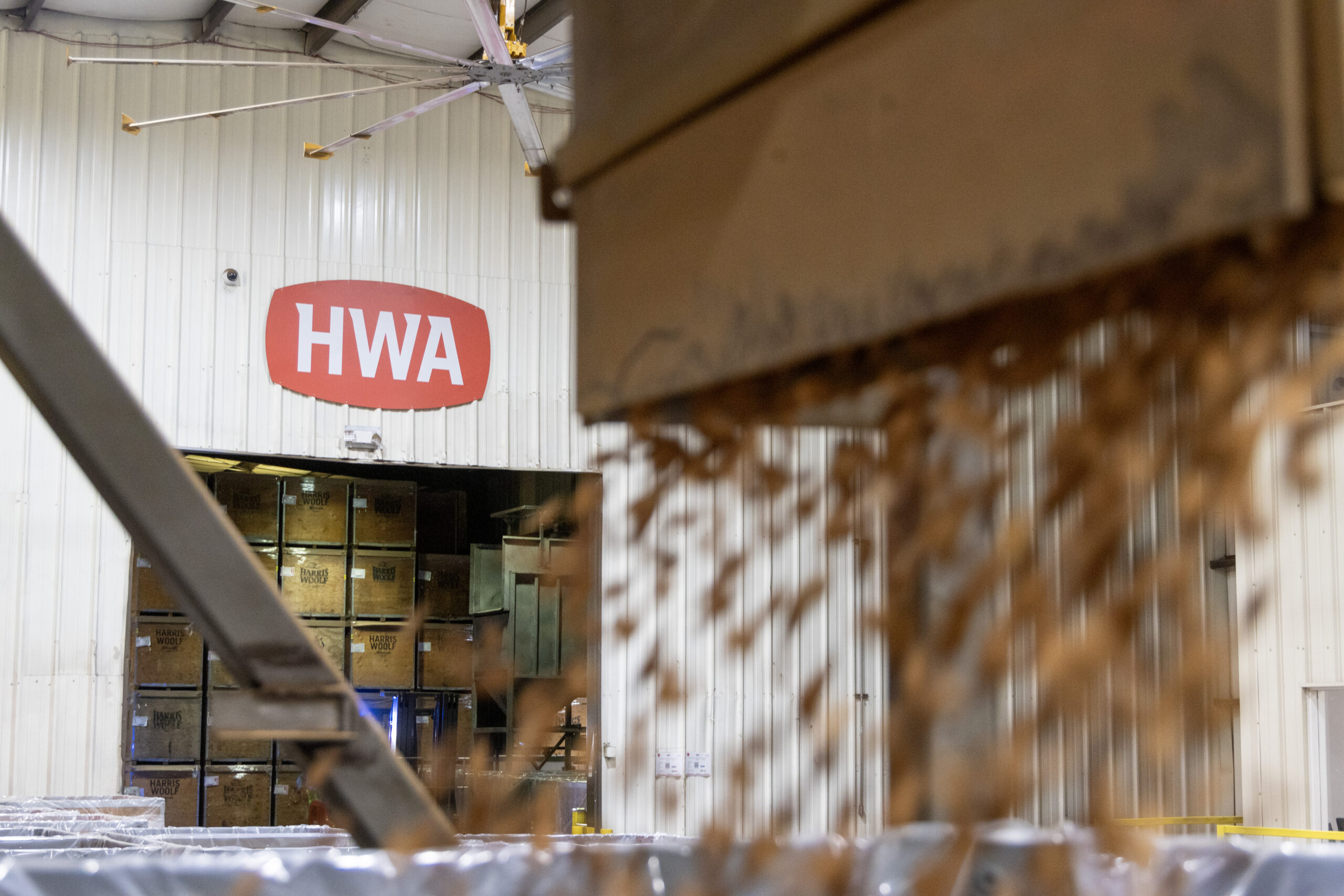Many of today’s consumers recognize the impact that their food choices have on the environment, but they struggle to determine the best way to manage their dietary needs while balancing their commitment to sustainability. A recent Economist article highlights a new way of looking at this decision — one that they call the banana index. The banana index encourages consumers to consider the weight, calories, and protein of the food they consume in order to determine if it’s a carbon-friendly choice. It’s a better way of making an apples-to-apples — or bananas-to-bananas — comparison.
This metric is particularly insightful in terms of almond production. Almonds have long been perceived as an energy and water-intensive crop, but when you pin almonds against animal products and even other plant-based foods, you may find that their nutrition and carbon impact prove common criticisms to be out of context.
Understanding Water Almond Usage: How Much Water Does It Take to Grow Almonds?
Almonds are one of the most delicious, nutritious, and protein-packed snacks on the market. In fact, comparisons like The Economist’s banana index show tree nuts are one the best conversions of water to protein.
Almond trees are cultivated in select locations around the world, particularly those with Mediterranean climates. The state of California is the largest almond-producing region in the world, accounting for the majority of global almond production.
Of course, water is a major factor in the growth of delicious, nutrient-rich California almonds. While all fruits, legumes, and drupes require a large water supply to survive, it’s worth noting that high-protein tree nuts, such as almonds, need more water in order to convert their sugar into protein. During a typical growing season, an almond tree will require 40 inches of water in order to thrive.
With the support of research, technology, and industry leaders, California almond growers work diligently to reduce their water footprint and use only what is necessary to farm these nutrient-rich, protein-packed nuts.
 Factors that Contribute to Water Usage in Almond Production
Factors that Contribute to Water Usage in Almond Production
- Irrigation Methods — Flood irrigation water techniques are a method of irrigation that involves the collection of water and the subsequent distribution of that water at once to crops. While it is still used today, it is not the most efficient way to irrigate and is gradually being replaced by better options like drip irrigation. Drip irrigation, on the other hand, relies on a system of pipes that slowly drips the water supply to the plants over a longer period of time. It keeps the plants hydrated while relying on less water.
- Water Management — California almond farms and producers have long had to learn how to deal with the impact of water stress and water shortages from prolonged drought conditions. Almond orchards that effectively implement scheduling and monitoring processes are able to do more with less water, ultimately reducing their dependence on water resources without compromising the quality of their products.
- Pest and Disease Control — Prioritizing efficient pest and disease control can reduce the water stress of crops, and minimize the amount of water that is required to grow the plant.
Factors that Contribute to Carbon Emissions
Like any product with an established supply chain, harvesting, producing, and distributing almonds can contribute to carbon emissions. The following are key supply chain stages and their impact on the carbon footprint of almonds:
- Agricultural Practices — All California farmers deal with the reality that land preparation, tree planting, fertilizer application, and pest control can generate carbon emissions. The use of synthetic fertilizers, especially those containing nitrogen, can release nitrous oxide, a potent greenhouse gas. Additionally, if not properly managed, the decomposition of organic matter, such as pruned tree branches or discarded almond hulls, can produce methane emissions.
- Irrigation — As mentioned earlier, almonds require significant water for irrigation. If irrigation practices are not optimized, and water is inefficiently used or lost through evaporation or runoff, additional energy may be required for pumping and distributing water, leading to indirect carbon emissions.
- Harvesting and Processing — The mechanical harvesting of almonds typically involves the use of machinery and equipment powered by fossil fuels. The energy consumed during almond processing, including hulling, shelling, and drying, can also contribute to carbon emissions if plants heavily rely on conventional energy sources.
- Transportation — Almonds are often transported over long distances from production regions to processing facilities and then to distribution centers or export markets. Transportation, whether by road, rail, air, or sea, can generate carbon emissions depending on the distance traveled and the mode of transport used.
- Packaging and Waste — Packaging materials, such as plastic bags or cardboard boxes, contribute to the carbon footprint of almonds if they are not sustainably sourced or recycled.
Almond Water Usage & Carbon Footprint in Context
As with any type of data, it’s important to keep it all in context. On the surface, almonds appear to utilize more water and present a drain on natural resources, which can lead some to think that these powerful nuts are not an eco-friendly choice. In reality, it’s important to consider other metrics that can give you a comprehensive assessment of the foods you are choosing.
Almonds do require a lot of water to produce — that is true — but these nuts are a valuable conversion of water to high-protein, low-carb, and vitamin-packed ingredients. They also weigh less than other foods that need to be transported. By considering the nutritional value and the weight of the food you choose, you can make contextual decisions that are best for your health and for the environment.
Meat and dairy products, for instance, take a major strain on the environment. Raising livestock to become food that is produced on a mass scale requires an abundance of natural resources, including water. According to The Guardian, meat accounts for almost 60% of all greenhouse gasses in food production. This statistic results from a combination of the acreage, machinery, water, energy, and transportation required to produce meat. It’s also worth noting both cattle and chickens release methane into the air which contributes to a significant amount of greenhouse gas emissions.
So, put into perspective, almonds do require a large amount of water and energy to successfully grow, but the nutrients, carbon emissions, and versatility of almonds prove to exceed animal-based products almost every time, making them an eco-friendly, healthy choice for consumers and manufacturers alike.
Plus, by relying on growers and processors who innovate and implement sustainable farming practices, individuals and organizations can invest in a quality almond product that is less taxing on our precious energy and water resources.
Advancements for Water & Energy Efficiency: Harris Woolf Almonds
To make sustainable, clean, and high-quality ingredient solutions more accessible, almond industry leaders continuously research and test new strategies around growing, harvesting, and processing almonds. As a leading wholesale almond product producer, Harris Woolf Almonds is committed to building a network of sustainable almond practices. This network includes our grower system, made up of over 200 California farms and farmers, and our local almond processing plants. Sustainability is the focus on both sides of our operations — farming almonds and producing high-quality almond products. By strengthening our grower resources, industry presence, and processing methods, our goal is to increase almond availability while reducing the environmental impact.
 Almond Irrigation Technologies and Practices
Almond Irrigation Technologies and Practices
California farmers are actively working to employ the best irrigation technologies and practices to reduce waste and improve the quality of their crops.
While all products require water, there are many steps we can take to reduce waste and stretch resources further. Harris Woolf Almonds aims to identify those and share them with others to reduce water waste throughout the California agriculture industry. We continuously promote the responsible use of water through flow monitors, drip irrigation (as opposed to water-intensive irrigation systems), and the reutilization of wastewater. We even recapture water used in our almond processing facilities to be reused as irrigation water for crops.
New and exciting ideas continue to emerge with each passing day, as growers work to combat the prevalence of water stress while focusing on production levels and product quality. By using water with precision, we are able to provide our consumers with the delicious, flavorful almond products that they crave — all while giving them peace of mind, knowing that we are doing our best to protect the planet.
Almond Energy Efficiency
Sustainability doesn’t stop after harvest. Our local processing facilities have the same goal in mind in relation to carbon footprint reduction and water conservation.
HWA heavily invests in solar energy, with the end goal of having 50% of our company’s energy usage come from renewable sources. We are reaching this goal with solar projects in each of our Ballico and Coalinga facilities. Read more about our solar energy investment and other steps toward both environmental and community impact in our 2022 Impact Report.
The Climate-Friendly Focused Consumer
Consumers today are much more aware of the impact of their personal choices, and many are consciously working to choose nutritious products that are created using eco-friendly methods. With the demand for sustainable products growing, manufacturers are turning to ingredients and partners that help build clean and reliable food and beverage solutions.
With a fair environmental comparison and reliable producers, organizations and consumers can look to almonds and almond solutions as a nutritional addition to recipes and personal diets. From almond butter to formulate plant-based milk to almond powder to act as the base of protein-packed products, the nutrition, versatility, and sustainability of almonds stand out in the food and beverage industry.
Explore more about our sustainability efforts and contact us to learn about our nutritious, customizable, and delicious almond ingredients.















 Factors that Contribute to Water Usage in Almond Production
Factors that Contribute to Water Usage in Almond Production
 Almond Irrigation Technologies and Practices
Almond Irrigation Technologies and Practices